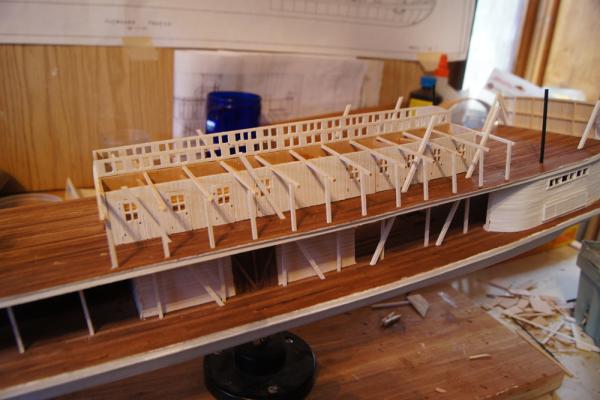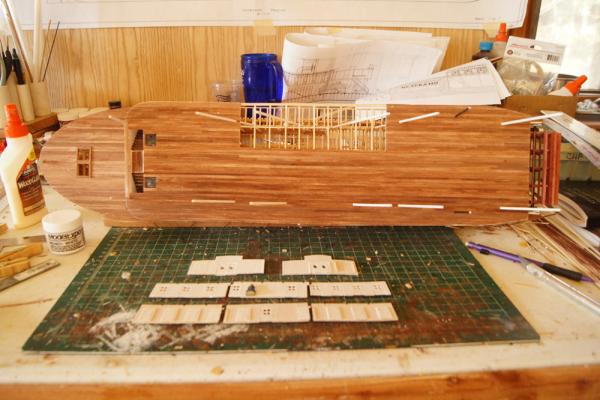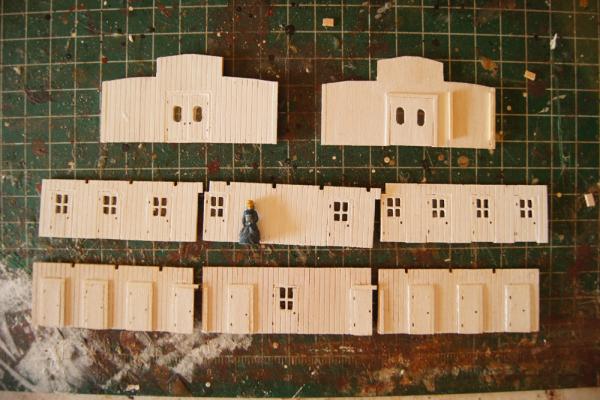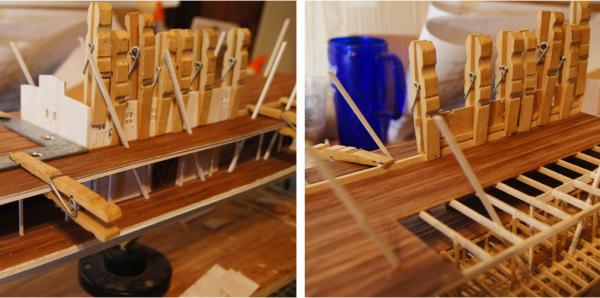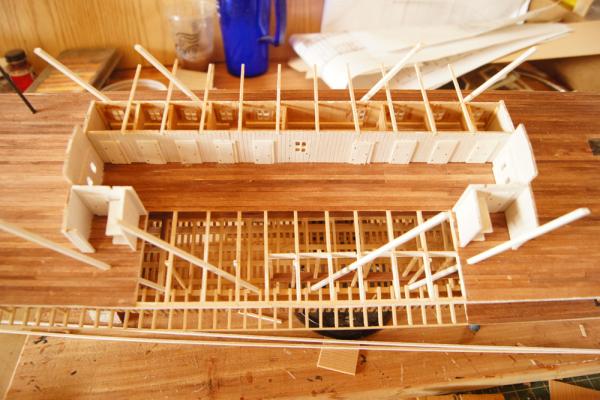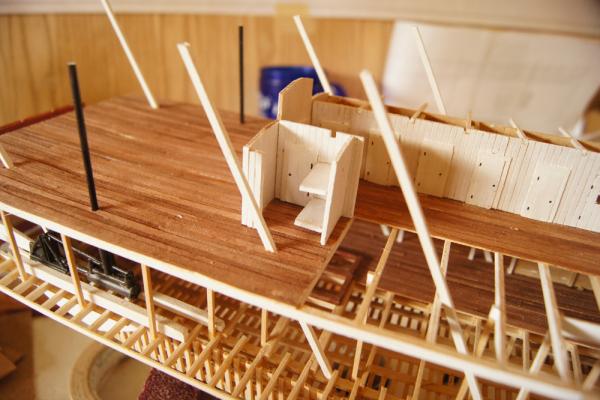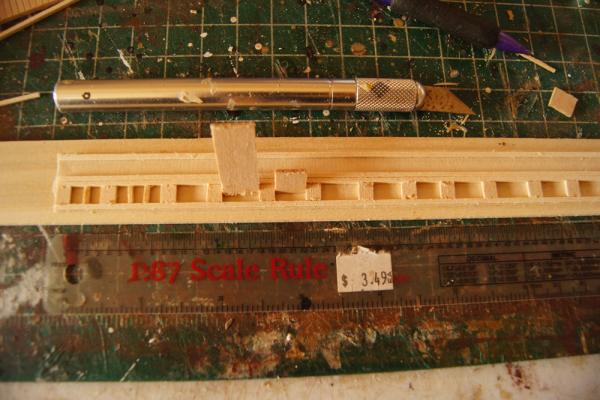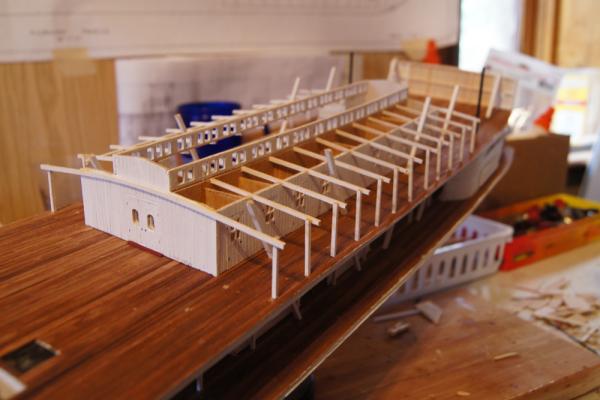-
Posts
3,420 -
Joined
-
Last visited
Content Type
Profiles
Forums
Gallery
Events
Everything posted by Cathead
-
Siggi, Apparently ropes (laniards or modern spelling:lanyards) were attached to the buckets. That line appears to refer to how the ropes were stored. A Flemish coil looks like this: and would be a very easy way to coil rope into a fire bucket for storage, as it would be out of the way but easy to pull out when needed (no knots). The English language loves to turn nouns into verbs, so in this case "laniards flemished close down inside" means that the laniards attached to the buckets were coiled tightly inside the bucket ("flemished"), disposing of the whole rope easily. At least that's what it means to me. It might also help to know the rest of the next sentence, which begins "some ships that do not stow", as it might shed light on this, assuming that sentence tells what happens on ships which don't stow their buckets and laniards in this manner.
-
Cairo was an ironclad gunboat, so it stands to reason she'd need more power than a lightly-built riverboat intended for speedy passage of cargo and passengers. I've visited Cairo at Vicksburg, it's a real treat to walk up to and around in person.
-
I've just been catching up on this log, especially interesting as friends of ours just spent 3 months in Sydney on sabbatical. I enjoy learning more about Australian history, it's a fascinating place. Thanks for this really unique and beautiful build. Forgive this question if it's been answered and I missed it, but what is the design purpose behind the rudder being angled like that, and curved in at the bottom rather than flat-bottomed? It looks very different from the (admittedly few) ship's rudders I can recall. Merry Christmas to you.
- 745 replies
-
- francis pritt
- mission ship
-
(and 1 more)
Tagged with:
-
Ironwork from steamboat wrecks was routinely salvaged, and indeed boilers, engines, and more were re-used on multiple boats. Bertrand's own machinery wasn't original, but was salvaged from another wreck and installed on the newly-built Bertrand. I went back and re-read the academic papers by Dr Crisman dealing with Heroine's excavation, and they did not directly explain the 4-boiler count, other than citing an earlier reference to general practice of the time. However, there's an interesting comparison to be made with reference to my earlier guess about boiler numbers being related to the support structures. Nowhere in the Heroine papers could I find a direct reference to the WIDTH of the boiler supports, though they are described in general. The area of Heroine's hull where the boilers sat was the most damaged, and didn't have any decking remaining to preserve more evidence. On the other hand, the Bertrand wreck did have the boiler-area deck intact, with special cross-timbers and decking in place to support the boilers, so we know for sure how wide that area was: about 10'. That's pretty narrow for a hull that was about 34' wide, not including the guards. As far as I know most steamboat boilers were around 3' in diameter (the papers state that Heroine's were 34"); that means Bertrand couldn't have had more than three boilers, and 2 seems more likely to accommodate the rest of the boiler structure. In comparison, Heroine is a much narrower boat, with a hull width of only around 20' (judging from the published diagrams), so four 34" boilers would have taken up 12'-14' of the total 20' hull width (though she also had guards). I believe Arabia's hull was about 30' wide, and we know she had 3 boilers. Finally, for whatever it's worth, Heroine is especially thin compared to later boats; her hull appears to be about 140' long though only 20' wide, compared to Bertrand's 161'x34'. This does NOT mean we should jump to conclusions about Heroine's boilers; there's no rule (to my knowledge) saying the boilers on a steamboat should be X% of the total hull width, and Heroine was built very early in the creative process of developing western riverboats, while Bertrand was built over 30 years later in a relatively more standardized age. But it is interesting to consider if/why Heroine had such a large boiler capacity for a small, one-engine boat compared to larger craft like Bertrand or Arabia, and I wonder if she turned out to be at all top-heavy given all that heavy power plant on such a narrow hull. I don't want to derail Glenn's build log into a longer discussion of other boats, so in general we should direct discussion of the Bertrand to my log instead. But in this case I think the comparison is interesting; I'm really interested in Glenn's thoughts or corrections on my guesswork here.
-
Glenn is right, that's the boiler from Arabia. The "flywheel" is part of the water pump, commonly called the Doctor, which is labeled in the image. I included one in my build but it's buried mostly out of view. I'll go read through Petsche again to see if I recover forgotten hints on boiler layout assumptions. I appreciate your kind words, Glenn, it's an honor to be of any service to a master craftsman.
-
In return, it's not clear (at least to me) how Jerome Petsche's reconstructions decided Bertrand had two boilers (they were salvaged shortly after the wreck, as I assume Heroine's were, iron being so fantastically valuable on the frontier). His drawings show them as such, but he doesn't discuss that aspect of the reconstruction in his book. It may have something to do with the dimensions and layout of the supporting structures for the boilers, which were preserved in the main deck of Bertrand and (I assume?) also on Heroine. A given width of support timbers may strongly suggest X number of boilers, given that most were made to similar plans/dimensions. Just to show the uncertainties involved, a privately-drawn set of Bertrand plans I initially started working with, before setting them aside as too inaccurate compared to Petsche's data, have Bertrand with three boilers. It's all very confusing. Thanks for the pump info! I'm loving learning more about this boat through your work, and again apologize if I ever over-step my bounds.
-
I'm not a sail expert, but wouldn't it partly depend on the conditions and context? My limited understanding is that topsails were generally used for light maneuverability in square-rigged ships, so in theory would often be the first set from a standstill, but I'm not sure of the procedure on a schooner rig.
-
I'm not sure about the initial aspects of the procedure, but as far as removing the hot material safely from the boat, many boats had a special ash trough that allowed the hot coals & such to be swept/washed away from the boilers, either over the side or through an opening in the guards. Here is a picture of the brick-lined ash trough from my Bertrand build. As for boiler explosions, they were quite common on western riverboats, due to a combination of high-pressure boilers, limited or no safety equipment (such as dial pressure gauges), limited knowledge/training of the engineers running the boilers, and a commercial (and passenger) culture which favored speed and power over safety and caution. For a long time, the only safety valve on riverboat boilers was a simple weighted lever, which was very easy for an ambitious engineer to over-weight or even tie down, increasing the pressure in the boilers. With no clear testing or standards, no one really knew what pressure boilers could hold, and there was no calibrated way to measure pressure. Water levels in the boiler also couldn't be measured easily (again, no gauges), so this too was guesswork and instinct. Thus, if water levels got too low, or levels fluctuated as suggested for Sultana, boom with no warning. All of this was made much more likely by the river culture of the time, in which the fastest boats received premium rates and reputations, regardless of safety concerns. In addition, river conditions could lead to explosions, as when boats attempted to force a bar or round a bend under high-water conditions, needing every ounce of steam in the attempt. One particularly deadly explosion in central Missouri happened after a boat repeatedly tried to round a bend in front of a towns-worth of onlooker, failing over and over and being swept back downstream in embarrassment, before the engineer apparently tied down the pressure valve and went for it all. The boat blew up mid-bend, sending debris into the onlookers on the bluff and killing many passengers. Glenn, I'm curious how you know the Heroine had four boilers. The number varied from boat to boat; I was surprised to learn that Bertrand only had two. Also, do you know what kind of pump the water supply used?
-
Mischief, there ARE plenty of beginner kits available, including some with pre-cut planks so you don't even have to shape them (much). But it's still not the manufacturer's job to hold the modeler's hand through even the most basic steps (Step One: Which end of the knife to use). At some point people should take responsibility for learning a new skill, not demanding that everything be handed them on a platter (this goes for modeling building, too).
-
A clarification: pre-scribed wood is just what the doctor ordered for a situation like this cabin structure, but I didn't do the scribing myself. You can buy sheets of pre-scribed wood in various thicknesses, dimensions, and styles. For example, you can get plank-style like I used, or board-and-batten. I've built a fair amount of structures with it for my model railroad (based on a Missouri River port town during the steamboat era), and have a variety of scrap left over that was easy to repurpose for this project. I used it here because building a frame and planking both sides would have made the walls far too thick at this scale (1:87), and I don't have any wood thin enough to do that in scale (and I'd be afraid it'd be too fragile anyway). These boats were built cheap and fast, and these stateroom walls were knocked together from thin pine. Actual framing worked fine on the main deck, because those walls weren't finished on the inside and so it's necessary to show the framing, and doesn't look too thick because you can't easily see the ends. But having stateroom walls well over a scale foot thick would have looked ridiculous; if nothing else the windows would have looked wrong, either too thick or too recessed. I couldn't see another way to show cabin interiors without using solid sheets of wood at this scale. If I'd built the cabin whole, I probably would have framed and planked it, because I wouldn't have cared about the interior look or depth, but saw this as a compromise to allow the interior view. avsjerome, thanks for that snippet. I've read about the steamboats on the Columbia and such, including the famous first trip down the rapids showing that it was possible, but I never knew that Idaho itself was named after a steamboat.
-
With the boiler deck planked, apart from a section I left open for internal views, I moved on to building the cabin structures. Typical riverboats of this design had two lines of crew/passenger cabins (usually called staterooms), separated by an open main cabin (or parlor) down the centerline in which meals were served and folks could socialize. Only stateroom passengers were allowed in here; those paying for deck passage fended for themselves on the semi-open main deck. The forward-most staterooms would be used by the captain, pilot, clerk, and engineer, then a few mens' staterooms, then a larger room on each side used as galley & storage, then more staterooms aft. Generally the aft-most section of the main cabin was carpeted and reserved for ladies & families only, along with the aft-most staterooms, to save their exposure to cigars, spittoons, cursing, and other male tendencies of the period. The boiler deck has a slight, but clear, sheer both fore and aft (especially aft). So I couldn't just assemble nice, straight walls and set them down, I had to account for the curvature of the deck. The longitudinal walls were built in three sections, with notches to help each fit together. I filed slight angles into these joints, so that the sections fit together in a subtle curve, matching the deck. I cheated slightly with these, using sheets of pre-scribed wood rather than building frames for individual planks, as I did for the main deck structures. However, I did build all the doors and windows from scratch, as advised by the commentariat. In the photo above, the top row are the two ends of the cabin structure (one turned over to show the bracing for the walls), the middle row are the outer walls of the port staterooms, and the lower row are the inner walls of the port staterooms. Lady for scale. I only build the port-side walls, leaving the starboard side open for views of the inner main cabin. I started installing the walls by clamping squares across the deck to guide the fore end (not sure "bulkhead" is appropriate in this context). Then I glued guide strips of scrap wood along the deck, inside the runs of the port walls where they wouldn't be seen, and used these as gluing and clamping guides for the walls. Each 1/3 wall was glued in, then the next one sanded to fit and glued in, then the last one. Above is the completed cabin structure. By not exposing the interior of the port staterooms, I was better able to support and straighten them with internal stringers. In return, I built two open-sided staterooms at the fore and aft end of the starboard side, to allow a view of the interiors, but left the rest open for better internal views and light. The main cabin should have tables, chairs, wood stoves, chandeliers, and so on, but I'm not up for building all that right now. I'll always have access to this area if I choose to detail it later on. A closeup view showing how small these staterooms were, just two bunk beds at most 6' long and perhaps a small cubby for hanging clothes. These were rough frontier boats, not the floating palaces of the lower Mississippi River. Toilets and laundry facilities were at the stern, and will be built and explained in a later post. In this photo you can also see that I managed to install the forgotten engine vent stacks just fine (note: the main smokestacks were actually called "chimneys" on riverboats; I don't know if this terminology extends to smaller stacks). Main cabins had a raised clerestory with skylights along the length, allowing light into this central area. Thus I needed to build two of these long, narrow structures complete with regular windows, but strong enough to span the open, unsupported stretch on the starboard side. I did this by laying out two parallel beams on double-sided tape, then setting my cutter to the inside dimension and cutting lots of filler pieces. Using spacers, I laid out the window pattern along the whole structure, then glued in the spacers. When the whole assembly had dried, I peeled it off the tape, sanded it smooth, and painted it. I built two of these one right above the other, so I could visually line up the spacers and ensure the two pieces were identical. And here's the result, along with a good start on the beams supporting the hurricane deck (supposedly named for the constant breeze up there). And here's a better overall view from an angle, giving a sense of the cabin's overall structure and placement. Next tasks: Frame in the rest of the hurricane deck (also serving as the cabins' roof), which extends forward as far as the boiler deck does, but aft only to the end of the cabins. In other words, the forward boiler deck is covered but the after boiler deck is open. Build the aft-most structure, housing the pit toilets (opening into the wheel) and laundry. Lay out and install the hog chains, iron rods which extend longitudinally through multiple decks and support the fore and aft weight of the boat, preventing it from hogging (particularly from the weight of the sternwheel). When I started this project, I had hoped to complete it by the end of the year. That seems unlikely now, but the end is nevertheless in sight. It's exciting to see the Bertrand really taking on its full form, beyond the barge-like appearance it's had for so long. No music this time, too busy to come up with something interesting. Thanks for reading, and Merry Christmas or whatever seasonal salutation warms your cockles.
-
Which just goes to illustrate another point made in this thread: do some research before you drop money based on a pretty picture. Caveat emptor applies to models too.
-
I think Steve nails it with regards to the model's look; it has a beautiful patina that really stands out to me.
-
Good point that it wasn't JUST Pittsburgh, I over-generalized there. But I think the broader point remains, that even early steamboat machinery was mostly being manufactured in the Ohio valley and thus was built/adapted specifically for the boats, even if using generic industrial designs as a template. I hope I'm not over-reaching here, you're certainly more of an expert than I, and I don't mean to tell you your business. Just thought the readership would enjoy some more information on the subject, to chew on.
-
Here are some quotes which may shed some light on the question. All parantheticals mine; also any errors, as I transcribed these from the printed books. "The West", as used here, means the interior river basins of the United States, i.e. the Missouri, Mississippi, Ohio, and such, rather than the West of the Rockies and beyond. From Steamboats on the Western Rivers, an Economic and Technological History, by Louis C. Hunter, p. 124-125: From The Western River Steamboat, by Adam L. Kane, p.68-71: My understanding has always been that steamboat machinery was largely manufactured in situ in the west, as it was prohibitive to ship heavy machinery over the mountains from the east, or up the Mississippi from New Orleans (where there was no heavy metal industry to speak of at the time). Pittsburgh very early on developed iron working industry, and almost all western river boats were built along the upper Ohio River within easy reach of Pittsburgh's industrial capabilities. Thus it seems possible, even likely, to me that most steamboat engines, particularly any high-pressure ones, were built with steamboat use in mind, rather than being re-purposed industrial engines from some other source. The early ones may have been based on generic industrial designs for sawmills and such, but I'd bet Heroine's engine was built near her boatyard with her in mind.
-
Also, I've been skimming through a few of my references, which imply that steam engines were being adapted or designed specifically for western riverboat use pretty early on, certainly by the 1830s. So it's also possible that Heroine's engine, while based on a factory design, was also custom-built for her along similar lines. Certainly a number of early steamboat engines were salvaged from wrecks and put to use in basic land settings like sawmills.
-
Mark, This image shows a "typical" (if there is such a thing) steamboat boiler, including the mud drum:
-
Yeah, that is a really unique setup. Wish I could offer more intelligent commentary. Really appreciate that 3D drawing.
-
Read books. Study websites. Look for modelling videos online or in stores/libraries. Experiment by building your own basic models, or try assembling "mock" pieces to see what it's like. Start with very basic kits rather than something pretty but complicated. Really, it sometimes seems that too many beginning modelers are like someone who wants to learn German and so picks up a copy of Goethe in the original because it's impressive, then complains that Goethe used fancy words and they don't know how to translate them. With most models, but especially nautical ones, it's worth knowing something about the subject as well as the model technique. Why would anyone want to build a complex ship model and NOT inherently want to learn about what they're doing? Half the joy is learning about the subject material, not just assembling a random wooden thing. Before I ever built my first nautical model, I read multiple books on both the history of ship design in general and the techniques of wooden modelling in particular. Some of them I read twice. If I run across a word or concept I don't know, my reaction is "ooh, I get to find out what this is and how it works!", not "I can't believe they don't define every term!" This might've been harder to achieve 20 years ago, but the internet now makes this possible for almost everyone. To me, anyway, most of the joy in model-building is the doing, not the product. While (and usually before) I'm working on a model, I'm actively engaged in learning everything I can about it. Once it's done, it just sits there passively. Some instructions really do stink. But the purpose of instructions is to guide the assembly of the model, not to teach the modeler about modeling, in the same way that a recipe is intended to guide the preparation of a dish, not to teach the cook about cooking. Unless it is very specifically designed and described as a "learning" recipe or kit, it shouldn't be expected to do more than that.
-
Mikiek, in fairness to MS, the Niagara is hardly a beginner's model for someone with no prior experience. I do think instructions for kits of that complexity assume the modeler has some knowledge/experience with what they're doing. I think people really should start with a basic open boat or something before they tackle a fully rigged, armed brig or ship. Really, it's a lot like cooking. If you try to tackle a complex French recipe when your prior kitchen experience is limited to oatmeal and ramen, you shouldn't expect the the recipe to walk you through concepts like browning, deglazing, or julienne. It's fair for that recipe to make some assumptions about the cooks' knowledge.
-
After reading this thread, it occurs to me that I should bring a few copies of "good" and "bad" kit instructions to my class, so people get first-hand experience with the importance of that aspect of kit-choosing. I've seen so many examples on this board of people turned off by modelling by instructions, maybe I can head a bit of that off. Of course, that assumes anyone signs up for the class in the first place.
-
Ken, yeah, I just don't think sound would add enough to the model to be worth it. For locomotives, it is, because the combination of sound AND movement is really powerful. But for a static display model, I don't think sound would add anything. I can just call up a sound on a computer or phone if someone wants to know what a steamboat whistle sounded like. And yes, live smoke would look terrible, and static "puffy" smoke would look fake outside a photograph. My rule on details is to leave them out if they can't be done right; the eye is much better at noticing things that are wrong than at missing thing that aren't there.
-
Matt, Do you mean a static feature, like cotton balls, or a live feature, like some kind of generator? As a long-time model railroader I've seen (and tried) lots of ways of making static smoke features, and have been convinced by none of them. Rather, some look fine in photography, but not in real life. I think the eye is too good at judging what should be moving and what shouldn't be. In a photo, the eye accepts that nothing's moving, but in real life it sees cotton balls or something as this weird stationary thing. At least mine do; I tend to find such things distracting instead of enhancing. As for a live feature, I hadn't considered that, but I don't think there's anywhere to put it, given the open nature of the build. And I think I'm happy with the model "unenhanced". It's a good question, though.
-
jazzchip, for what it's worth, I am offering an "intro to wooden model building course" through my local adult-education center this spring. The goal is to focus on hands-on demonstrations and experiences with basic aspects of aircraft and ship modelling, right down to having a few open kit boxes for people to peruse and practicing how to bend and shape wood strips. My background in education tells me that many people are visual or experiential learners, whereas modelling instructions and books are almost all text-learning. Many people would benefit greatly from 1/2 hour with someone else live, which is what I'm hoping to achieve in my class. I'm far from a master modeler, but have built enough to be able to pass along a lot of basic help. I also intend to display a number of my models and have students critique them, a sort of "what did I do wrong" session where we can all discuss better ways of doing things. I hope it goes well.
About us
Modelshipworld - Advancing Ship Modeling through Research
SSL Secured
Your security is important for us so this Website is SSL-Secured
NRG Mailing Address
Nautical Research Guild
237 South Lincoln Street
Westmont IL, 60559-1917
Model Ship World ® and the MSW logo are Registered Trademarks, and belong to the Nautical Research Guild (United States Patent and Trademark Office: No. 6,929,264 & No. 6,929,274, registered Dec. 20, 2022)
Helpful Links
About the NRG
If you enjoy building ship models that are historically accurate as well as beautiful, then The Nautical Research Guild (NRG) is just right for you.
The Guild is a non-profit educational organization whose mission is to “Advance Ship Modeling Through Research”. We provide support to our members in their efforts to raise the quality of their model ships.
The Nautical Research Guild has published our world-renowned quarterly magazine, The Nautical Research Journal, since 1955. The pages of the Journal are full of articles by accomplished ship modelers who show you how they create those exquisite details on their models, and by maritime historians who show you the correct details to build. The Journal is available in both print and digital editions. Go to the NRG web site (www.thenrg.org) to download a complimentary digital copy of the Journal. The NRG also publishes plan sets, books and compilations of back issues of the Journal and the former Ships in Scale and Model Ship Builder magazines.




